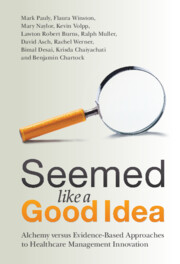51 results
30 Item response theory and differential item functioning of the AD8: The High School & Beyond Study
-
- Journal:
- Journal of the International Neuropsychological Society / Volume 29 / Issue s1 / November 2023
- Published online by Cambridge University Press:
- 21 December 2023, p. 240
-
- Article
-
- You have access
- Export citation
An approach for collaborative development of a federated biomedical knowledge graph-based question-answering system: Question-of-the-Month challenges
-
- Journal:
- Journal of Clinical and Translational Science / Volume 7 / Issue 1 / 2023
- Published online by Cambridge University Press:
- 14 September 2023, e214
-
- Article
-
- You have access
- Open access
- HTML
- Export citation
10 - Evidence and the Management of Health Care for Disadvantaged Populations
-
-
- Book:
- Seemed Like a Good Idea
- Published online:
- 14 July 2022
- Print publication:
- 28 July 2022, pp 332-368
-
- Chapter
- Export citation
Figures
-
- Book:
- Seemed Like a Good Idea
- Published online:
- 14 July 2022
- Print publication:
- 28 July 2022, pp vii-viii
-
- Chapter
- Export citation
Copyright page
-
- Book:
- Seemed Like a Good Idea
- Published online:
- 14 July 2022
- Print publication:
- 28 July 2022, pp iv-iv
-
- Chapter
- Export citation
7 - Evidence on Provider Payment and Medical Care Management
-
-
- Book:
- Seemed Like a Good Idea
- Published online:
- 14 July 2022
- Print publication:
- 28 July 2022, pp 246-273
-
- Chapter
- Export citation
Index
-
- Book:
- Seemed Like a Good Idea
- Published online:
- 14 July 2022
- Print publication:
- 28 July 2022, pp 409-412
-
- Chapter
- Export citation
Preface
-
- Book:
- Seemed Like a Good Idea
- Published online:
- 14 July 2022
- Print publication:
- 28 July 2022, pp xi-xii
-
- Chapter
- Export citation
Contents
-
- Book:
- Seemed Like a Good Idea
- Published online:
- 14 July 2022
- Print publication:
- 28 July 2022, pp v-vi
-
- Chapter
- Export citation
Contributors
-
- Book:
- Seemed Like a Good Idea
- Published online:
- 14 July 2022
- Print publication:
- 28 July 2022, pp ix-x
-
- Chapter
- Export citation
Contributors
-
- Book:
- Seemed Like a Good Idea
- Published online:
- 14 July 2022
- Print publication:
- 28 July 2022, pp ix-x
-
- Chapter
- Export citation

Seemed Like a Good Idea
- Alchemy versus Evidence-Based Approaches to Healthcare Management Innovation
-
- Published online:
- 14 July 2022
- Print publication:
- 28 July 2022
Very-High Dynamic Range, 10,000 Frames/Second Pixel Array Detector for Electron Microscopy
-
- Journal:
- Microscopy and Microanalysis / Volume 28 / Issue 2 / April 2022
- Published online by Cambridge University Press:
- 07 March 2022, pp. 425-440
- Print publication:
- April 2022
-
- Article
-
- You have access
- Open access
- HTML
- Export citation
Developmental Origins of Health and Disease, resilience and social justice in the COVID era
- Part of
-
- Journal:
- Journal of Developmental Origins of Health and Disease / Volume 13 / Issue 4 / August 2022
- Published online by Cambridge University Press:
- 28 October 2021, pp. 413-416
-
- Article
-
- You have access
- HTML
- Export citation
Characterisation of age and polarity at onset in bipolar disorder
-
- Journal:
- The British Journal of Psychiatry / Volume 219 / Issue 6 / December 2021
- Published online by Cambridge University Press:
- 25 August 2021, pp. 659-669
- Print publication:
- December 2021
-
- Article
-
- You have access
- Open access
- HTML
- Export citation
Wide Dynamic Range, 10 kHz Framing Detector for 4D-STEM
-
- Journal:
- Microscopy and Microanalysis / Volume 27 / Issue S1 / August 2021
- Published online by Cambridge University Press:
- 30 July 2021, pp. 992-993
- Print publication:
- August 2021
-
- Article
-
- You have access
- Export citation
Validation and implementation of group electronic hand hygiene monitoring across twenty-four critical care units
-
- Journal:
- Infection Control & Hospital Epidemiology / Volume 43 / Issue 7 / July 2022
- Published online by Cambridge University Press:
- 25 June 2021, pp. 834-839
- Print publication:
- July 2022
-
- Article
- Export citation
Polynomial-time approximation algorithms for the antiferromagnetic Ising model on line graphs
- Part of
-
- Journal:
- Combinatorics, Probability and Computing / Volume 30 / Issue 6 / November 2021
- Published online by Cambridge University Press:
- 12 April 2021, pp. 905-921
-
- Article
- Export citation
Sex differences in cognitive functioning of patients at-risk for psychosis and healthy controls: Results from the European Gene–Environment Interactions study
-
- Journal:
- European Psychiatry / Volume 63 / Issue 1 / 2020
- Published online by Cambridge University Press:
- 13 March 2020, e25
-
- Article
-
- You have access
- Open access
- HTML
- Export citation
Gender differences of patients at-risk for psychosis regarding symptomatology, drug use, comorbidity and functioning – Results from the EU-GEI study
-
- Journal:
- European Psychiatry / Volume 59 / June 2019
- Published online by Cambridge University Press:
- 01 January 2020, pp. 52-59
-
- Article
-
- You have access
- HTML
- Export citation



